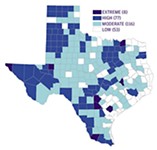The Austin Climate Protection Plan
How are we doing?
By Katherine Gregor, Fri., Dec. 7, 2007
It's daunting to achieve the massive shifts in behavior and human activity required to arrest global warming – and there's no time to lose. That's as true for the city of Austin – committed to doing its part through the 2007 Austin Climate Protection Plan – as it is in every other corner of the globe. At the ACPP's February launch, it was clear that achieving the milestone goals – set for 2012 to 2020 – would be a marathon project. The Municipal Plan alone requires a wholesale re-examination of how every city department thinks, operates, and does business in order to realize the maximum possible reductions in the city's carbon footprint. That scale of change isn't going to happen in a day or even in a year.
Always complicating matters is the fast-evolving national and international landscape of related research, practices, and technologies and the current lack of sufficient renewable energy. The good news at year-end: The city has made substantial incremental progress. The five big ambitious goals and individual subgoals of the ACPP – cited by national climate-change experts as an outstanding municipal model – are being translated steadily into real, on-the-ground progress.
The welcome news includes Austin Energy securing enough new wind power to reopen its popular GreenChoice program to the general public. For 1,000 kilowatt-hours, the Batch 5 GreenChoice residential customer will pay $108.85, compared to $90.35 for customers on the regular fuel charge. But because GreenChoice rates are locked in for 15 years, they should become a bargain. GreenChoice reopens Jan. 14, and Batch 5, like its predecessors, is likely to sell out. (For more information, e-mail [email protected].)
One Austinite bullish on the city staff response is City Manager Toby Futrell. "It's been amazing to me!" said Futrell of the enthusiasm, commitment, and results she's witnessed across city departments. Because "environmental values were already ingrained in every department," city staffers were able to get rapidly onboard. Working groups from every city department have formed and have begun slogging through the details required to establish baseline energy use and emissions audits and to begin drafting departmental plans. A cross-sector group of team leaders from about 15 departments meets monthly; the city manager and all department directors receive a monthly progress report, and council members receive regular briefings.
Within Austin Energy, Ester Matthews was named ACPP director but had no dedicated staff and few resources until the new city budget kicked in. As of Oct. 1, the ACPP finally gained its own budget, which with green building, demand-side management, and human resources funds will come to $1.25 million. (Over time, officials say, the city's energy savings should more than pay for the plan's administration and new investments.) The Climate Protection budget includes a team of eight staffers under Matthews; five should be in place by Jan. 1 to begin work on projects such as city departmental plans, an internal education program, an ACPP website, and a local carbon-footprint calculator and offset program. Given that the ACPP has been funded for just a couple of months, said Austin Energy Deputy General Manager Roger Duncan, "everything's ahead of schedule."
"We're making enormous progress," echoed Futrell. "The working teams are developing benchmarks and goals, and I see them getting knocked out very quickly. Every item has got motion, and it will go into hyperdrive next year when they get the Climate Protection staff on board."
Austin's Leadership
When Mayor Will Wynn announced the plan, it was in the spirit of pointing to the North Star. Wynn well understood the urgency of taking action on global warming; as chair of the Energy Committee of the 1,200-member U.S. Conference of Mayors since 2004, a leading member of its national Council on Climate Protection, and an Al Gore-trained Climate Project presenter, Wynn knew both the science and the stakes. With the full support of council and the city manager, Wynn unveiled an aggressive plan for Austin in February, promising "details to follow."
Some consider that fast-tracking born of conviction a liability. A Nov. 25 Statesman article, for example, painted Wynn as preferring the national stage on climate change, while "failing to get his hands dirty in policy-making at city hall," and not following through on ACPP projects. In fact, Wynn and his staff – particularly aide Matt Watson – have been steadfastly working along on ACPP policy details, program implementation, and community outreach. Wynn and Duncan both gather the latest research, knowledge, and best practices from experts and industry players at national events; both bring that expertise home and apply it.
Duncan cited a major benefit of the city's national reputation as an innovator: "Everybody knows what we're doing. When you become well-known as an absolute leader in the field, new technologies come to you." He fields calls and requests every week from researchers, solar manufacturers, and other enviro-tech companies that want to work with AE.
In November, Wynn hosted a green-building panel at the Mayors Climate Protection Summit in Seattle; he also shared Austin innovations at the Greenbuild International Conference and Expo in Chicago, which drew more than 20,000 international attendees. "Frankly, a lot of the time what I'm doing at these conferences is showing other cities how we do things in Austin," said Wynn. That's a role Duncan has played for a decade. "The rest of the nation looks to us for leadership – and this is no small responsibility," said Wynn. "We're not an island here; we're part of a larger national and international community – and I believe Austin absolutely has a responsibility to help push the dialogue."
Wynn discussed how he's constantly learning things from other mayors and cities that translate directly into new policy initiatives in Austin. For example, at last week's City Council meeting, he successfully brought forward a resolution to improve city performance on the groundbreaking 2000 commitment for all new municipal facilities to achieve silver certification for Leadership in Energy and Environmental Design. Afterward he told the Chronicle, "The policy we adopted today – which is more comprehensive than any you'll find in any other city – takes a very aggressive and methodical approach to making sure we will have the best municipal building practices in the nation. And it all started with the interaction I'd had with leaders from other cities."
Another resolution passed last Thursday directs staff to comprehensively review, make uniform, and potentially expand both voluntary and required green-building program policies, regulations, and programs. The intent is to raise the bar, likely leading to a required two-star rating (potentially itself toughened) for more projects. Green-building practices also will be pursued for affordable housing to lower monthly energy bills for low-income residents.
Duncan noted soberly that the real limitation on meeting ACPP milestone goals will be the rate at which alternative fuels, renewable energy, and technologies evolve. "The city's will and the money is there," he said. "The major issue is the supply and availability of renewable resources."
To Nuke or Not?
Nuclear power plants to replace coal-burning plants can help cut greenhouse-gas emissions but come with serious hazards and problems – notably, the storage of radioactive waste. Austin is a 16% minority partner in the South Texas Project, a two-unit nuclear power plant near the Gulf Coast. Majority partner San Antonio has already authorized $200 million in design work on nuclear reactors No. 3 and No. 4; dangling is a $1 billion subsidy from the feds to build it. Even longtime environmentalists who fought the nuke in the Seventies are now wondering if it's the lesser evil in today's climate.
A cautionary note from Will Wynn: Global warming projections show the Gulf of Mexico rising substantially and rapidly enough to potentially flood the site of the South Texas Project. New reactors have about a 50-year working life. Radioactive materials under seawater could present a true disaster scenario.
Got something to say on the subject? Send a letter to the editor.









